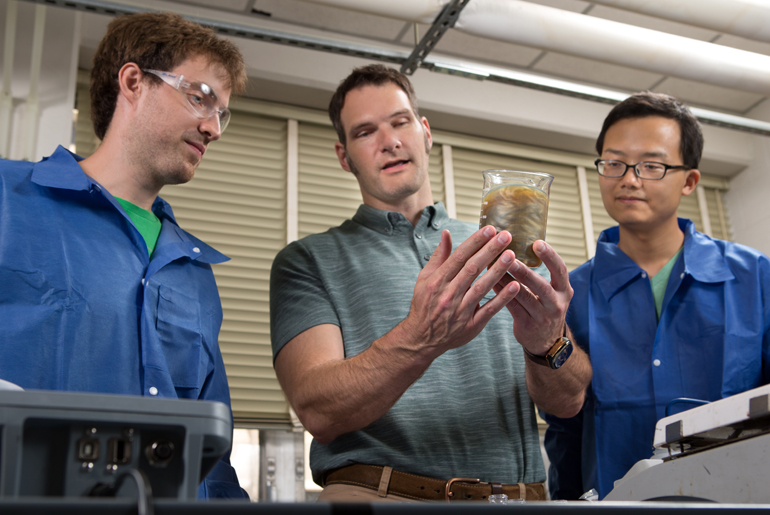
Dr. Jaime Grunlan (center) discusses the behavior of a clay solution to Ph.D. students Ryan Smith (left) and Yixuan Song. These clay solutions are used in producing clay-based nanocomposite thin films and coatings for the Sandia project.
The Polymer Nanocomposites Laboratory at Texas A&M University, directed by Dr. Jaime Grunlan, is working with scientists at the Sandia National Laboratory to reduce or eliminate arc faults and corrosion in solar cells. Corrosion in photovoltaic cells, which convert light into electricity, can damage connections and reduce or destroy the ability to generate electricity. Sandia Labs recently issued a press release detailing multiple approaches to corrosion research, which has been picked up by several news outlets.
The specific goal of Grunlan’s research with Sandia is to prevent arc faults, which are discharges of electricity that can occur when electrical connections are corroded. Initial testing suggests the thin clay-based nanocomposite coatings developed at Texas A&M could also be used as anti-corrosive layers within the cells to improve durability/lifetime. The coatings developed within Grunlan’s research group are being evaluated as barriers to moisture and corrosive gases. Testing is being done at Sandia as part of the larger Durable Module Materials National Lab Consortium (DuraMat), which is seeking to benefit the photovoltaic industry.
“It’s exciting to see how our long-term research in gas barrier and flame retardant coatings is being used to improve the efficiency and longevity of solar cells. We are solving complicated problems using low-cost and environmentally benign materials, which is an added bonus,” Grunlan says.
In the release, Erik Spoerke of Sandia’s Electronic, Optical and Nano Materials Department compared the development of these nanocomposite films, some of which can be 100 times thinner than a human hair, to building a house.
“It’s about assembling those structures in the right way so that you can use inexpensive materials and still get the benefits you want,” Spoerke says. “If you build a house, it’s not just piling together the drywall and two-by-fours and shingles. You’ve got to use the two-by-fours to make the frame, set the drywall on the two-by-fours and assemble the shingles on the roof.”
The overall goal of the research is to bring down the long-term cost of solar panels and solar technology. Being able to slow down corrosion in solar panels using inexpensive materials like clay so that they last longer and stay efficient could help facilitate faster adoptions of solar technology.
Grunlan’s project with Sandia is an industry-sponsored project through the Texas A&M Engineering Experiment Station. Grunlan is the Linda & Ralph Schmidt ’68 Professor in the Texas A&M Department of Mechanical Engineering.
Source: Texas A&M




